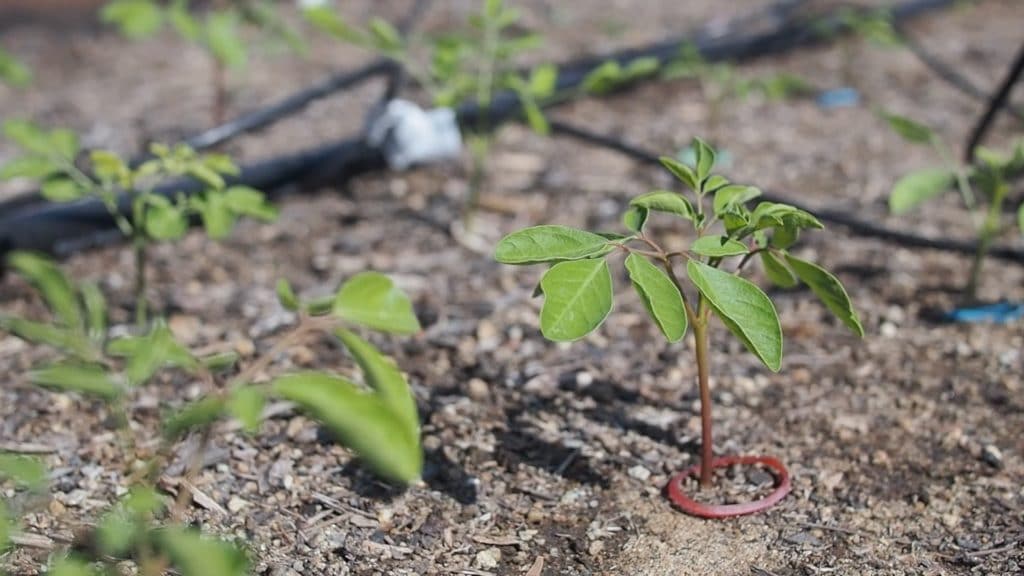How are the moringa seedlings in the ‘Intensive Moringa Cultivation’ doing? Watch this video to see how things look 16 days after planting.
Through this series you can follow a small scale ‘Intensive Moringa Cultivation’ that was carried out in Poway California. Germination rates, plant height, stem diameters, leaf yield and environmental conditions will be shared to give you as much information as possible. You will have an up close view into what an ‘Intensive Moringa Cultivation’ looks like and the leaf production you can expect under similar environmental conditions. For us, growing moringa in Southern California, moringa growth and therefore leaf yield will be limited by lower than ideal temperatures. This intensive moringa cultivation is being done to gain experience with watering requirements, potential leaf yield, and general knowledge about growing moringa.
Please comment below if you have any comments or questions. If you have ever had experience with an ‘Intensive Moringa Cultivation’ I would love to connect with you so please send me an email.
Transcript:
We’re back at the raised bed with the intensive Moringa planting, and today is day 16 since we’ve sown the Moringa seeds. Uh, again, our first seedling emerged on day five. And the seedlings continued to emerge until day 13. But over the last three days we haven’t seen any additional seedlings emerge. Uh, and so I’m going to share with you the germination rates at this time.
So the germination rate surprised us in two ways. Our first surprise was with how well the control group of seeds did. This was the seeds planted without any alterations at all. And these seeds germinated at a rate of 88%, much higher than we anticipated. Our second surprise was with how poorly the hydro-primed seeds did. Those are the ones we soaked and dried before planting. The hydro-primed seeds had a germination rate of only 55%. Now we think we’ve identified the reasons why the hydro-primed seeds did so poorly, and I’m going to share those reasons with you on a post on the website. But let me summarize by saying we didn’t control the temperatures through the process as closely as we should have.
So if you’re planting Moringa seeds now, go ahead and, plant them as they come out of the bag. Don’t worry about any seed treatment. These seeds should do fine without any help. So, what kind of growth are we seeing in this bed? Well, the larger seedlings you see in here have been growing above the soil for nine or ten days. And these seedlings have already reached a height in many cases of 3 to 4″. So these seedlings are growing about 1/3″ to 1/2″ a day, which we think is really exciting.
The temperatures in the bed have been, have been kept elevated with a row cover. We’re using those day and night. They keep the soil temperature about 60 at night, and the soil reaches over 100 during the day. And the air temperatures get a little cooler at night, in about the mid-50s, but in the day they’re hitting about … the air temperature’s hitting about 110 degrees. So we’re keeping things artificially warm in here right now until the temperature outside warms up a little more.
That being said we’re going to replant where the seeds haven’t germinated. We’re going to replant real soon. We’re going to fill in the rest of this bed to the density we wanted to have it at. And then we’re going to continue to closely monitor the growth in here. We’ll give you updates on stem heights and diameters on average as well as leaf yield. We plan to do our first harvest in about a month and a half to two months from now, and we’re really interested to see what kind of yield we can get out of a bed this size. Again,16 feet long and 4 feet wide. For those results and to follow this again, visit the website: ahealthyleaf.com. And once again, thanks for watching.
- Help, I’m having trouble using my Moringa Oil! - February 22, 2023
- Want to grow (and eat) Moringa? - April 14, 2022
- Can Moringa help protect you from the Coronavirus COVID-19? - March 15, 2020

